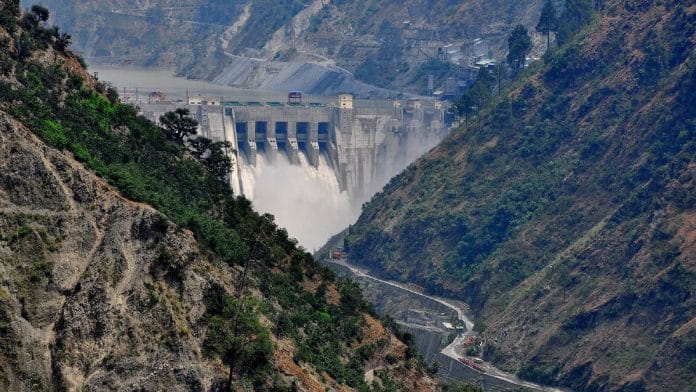New Delhi: Having put the Indus Waters Treaty (IWT) in abeyance in the aftermath of the Pahalgam terror attack, India over the weekend initiated flushing of the reservoirs of Baglihar and Salal—its two run-of-the-river hydroelectric power projects on the Chenab river in Jammu and Kashmir.
Flushing is a technique to remove accumulated silt and sediment from a reservoir or dam by release of high flow of water which then carries the sediment downstream.
A senior Indian government official confirmed to ThePrint that the process of flushing the reservoirs of the 900 MW Baglihar and the 690 MW Salal hydropower projects in Ramban and Reasi districts, respectively, started during the weekend.
“Once the flushing is complete, the reservoirs will be refilled. The entire process will take anywhere between a week to a fortnight to be completed. During this period the flow of water downstream to Pakistan will be hit, impacting the ongoing sowing of kharif crops,” a second government official told ThePrint.
The official added that with scarce water flow, Marala barrage located downstream near Sialkot district in Pakistan’s Punjab won’t be able to release adequate water for irrigation, affecting sowing of kharif crops like paddy, maize and cotton that will begin shortly.
Since both Baglihar and Salal are run-of-river projects, they have limited storage capacity and can’t be used to choke the flow of water for a prolonged period.
Government sources added that with the IWT on hold, India can choose to flush the reservoirs on its western rivers—Indus, Chenab and Jhelum— anytime it wants. The IWT mandates flushing of reservoirs only in August, during peak monsoon season.
In the absence of flushing, silt and sediments are deposited in the reservoirs over a period of time and affect operational efficiency.
The decision to initiate flushing of the Baglihar and Salal dams during the current lean season is among punitive measures India has initiated against Pakistan, whose involvement it suspects in the terror attack that claimed the lives of 25 tourists and one local Kashmiri in Pahalgam on 22 April.
Under the IWT, Pakistan is allowed unrestricted use of waters of the three western rivers, which is roughly 80 percent of the water carried by the Indus system, while India has the right to use water of the eastern rivers, Sutlej, Ravi and Beas.
India is also allowed use of water from the three western rivers in “non-consumptive” ways, including for domestic and agricultural use and run-of-the-river hydropower projects to generate electricity, subject to design and operation criteria set out in IWT.
A ‘run-of-the-river’ plant generates power without live storage as an integral part of the plant, except for pondage and surcharge storage.
Also Read: India can keep the Indus Waters Treaty ‘in abeyance’, unilaterally. Here’s why
Flushing reservoirs, a short-term measure
Flushing of reservoirs of the 900 MW Baglihar and 690 MW Salal hydropower projects is among short-term punitive measures India has decided to initiate against Pakistan.
The decision to flush the dams now, in a lean season, will also impact power generation at both hydropower projects, said the second official quoted earlier. “But because the water flow is less, the generation loss will also be less,” said one of the officials quoted earlier.
As of 1 May, Baglihar hydropower project was generating 150 MW of electricity while Salal was generating 115 MW, according to a daily generation report compiled by the Central Electricity Authority of India.
To better harness water of the three western rivers, government officials admit, India will have to ramp up its infrastructure. “We have not developed adequate storage capacity currently on the western rivers to better utilize our share also,” said the first official.
The water India can use from the western rivers has the potential to generate 18,569 MW of hydropower. However, as on date, India has only developed 3,500 MW of hydel generation capacity. Besides, India can use water to irrigate 13.4 lakh acres of land, but is currently deploying it for just 8 lakh acres.
India, it is learnt, is exploring multiple options to better utilise the water of the Indus, Jhelum and Chenab including a proposal to build a 10-12 km tunnel to transfer water from the river Chenab to Ravi. The proposal to build a tunnel on the Chenab came up at two high-level meetings on 25 April—one at the Prime Minister’s Office (PMO) and the other chaired by Union Home Minister Amit Shah—to discuss ways to harness the water of the three western rivers for use by India, senior government officials said.
Fast-tracking ongoing work on hydropower projects on the Chenab was also discussed. Work is in various stages of implementation at four hydropower plants: 850 MW Ratle, 1,000 MW Pakal Dul, 624 MW Kiru and 540 MW Kwar, located in J&K’s Kishtwar district.
Besides, the Ministry of Power has also been told to fast-track work on four proposed hydropower projects on the western rivers, namely the 1,856 MW Sawalkot, 930 MW Kirthai-II, 260 MW Dulhasti Stage-II and 240 MW Uri-I Stage-II, also in Jammu & Kashmir.
(Edited by Amrtansh Arora)







Still the print is not sure that culprit is pakistan. and those murdered were 28 Hindu’s. Shame on you for such biased portrayal of facts